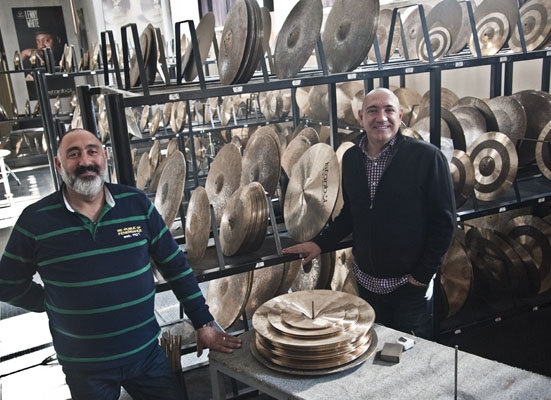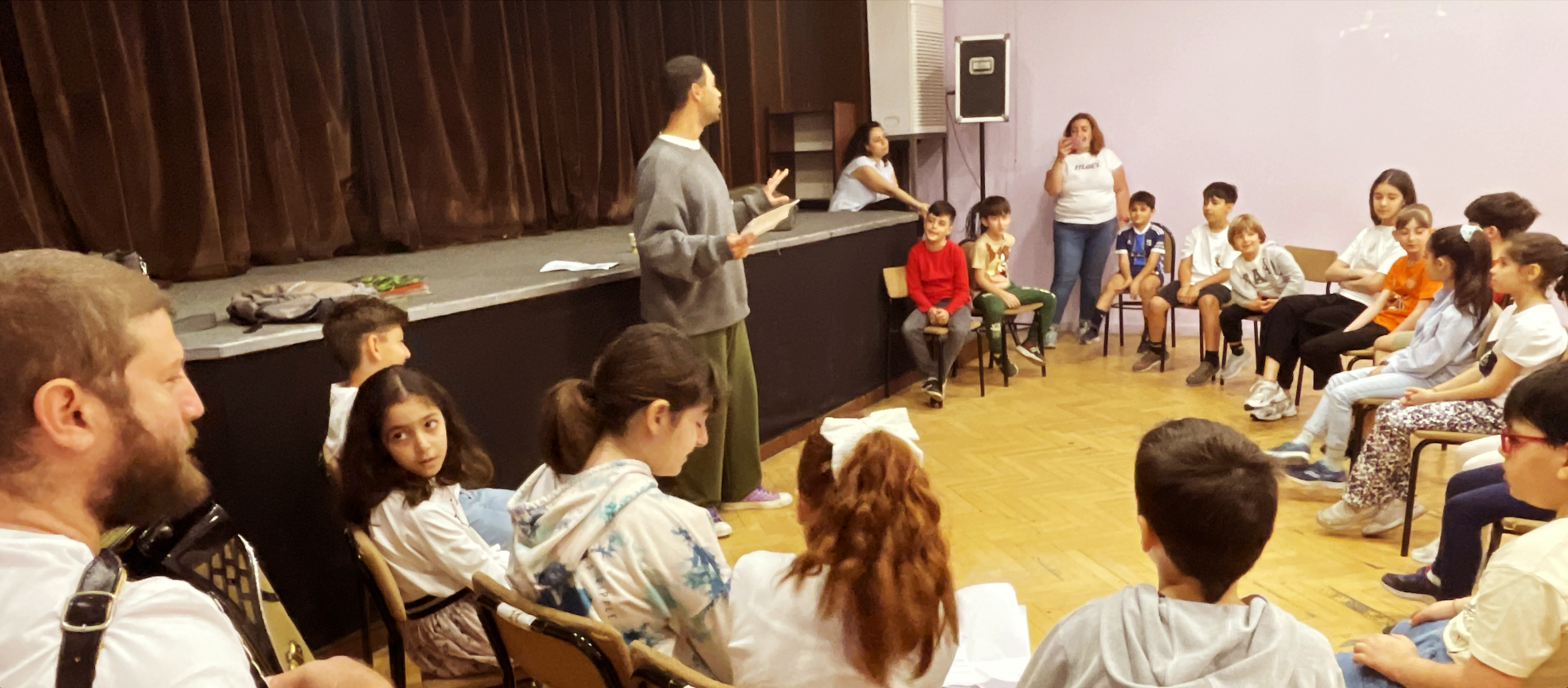Sarkis and Arman, the young heirs of Istanbul Agop Cymbals, explain the subtleties of the art of cymbal making
KARİN BAL karinbal89@gmail.com
Once the capital of cymbal making, it was the Zildjian family that first came to mind when one mentioned cymbals in Istanbul. When they migrated from here, the Zildjians thought they had taken the formula for cymbal making with them. However, Agop Tomurcuk, who began working as an apprentice at a young age with the Zildjians, also knew the secret formula passed on from father to son. Mr. Agop’s firm, which continued to practice the craft in his own workshop, later took the name Istanbul Agop Cymbals, and became one of the few firms that produced handmade cymbals with traditional methods. We visited the young heirs of Istanbul Agop Cymbals, Sarkis and Arman Tomurcuk, at their workshop in Hadımköy, to hear this interesting family story.
Your father made cymbals, but you first entered the jewellery business, how did that happen?
Sarkis Tomurcuk: I was 12 years old when I first made my way to the Grand Bazaar. Beginning as an apprentice, once I became a master jeweller, I opened my own store. My father didn’t want us to be in his line of business, that is why we learned a different craft. But when we decided to continue my father’s work, I closed my own store.
Arman Tomurcuk: I began working at the Grand Bazaar after primary school, too. But we always thought my father’s work was very interesting, and a line of business that could open onto the world. Our father wanted at least one of us to stay in his line of business. I insisted on it a little, because I really wanted it. After returning from military service, I went to England for language education for a year. Thanks to my father, who was a man with modern views.
Did your experience in jewellery making contribute to your practice in cymbal making?
A.T.: The work we do now is almost the same with jewellery. The only difference is that we work on a larger object. You use a melting furnace and pot in jewellery making as well; ours are 10-times the size. You use pincers and files to shape gold and silver; we use larger pincers and hammers to shape metal. We produce new cymbal models about every two years. We believe that the foundation of our craft was our design experience in jewellery making; we have the advantage of adopting a more aesthetic viewpoint.
Can we hear your father’s story in cymbal making from you?
S.T.: Our father is originally from Samatya. Our mother was born in Eğin; her family first migrated to Adapazarı, and then came to Istanbul. My father, whose birth date is 1941, began working as an apprentice at the Zildjian workshop on the street below the Surp Kevork Church in Samatya when he was about eight or nine years old. His brothers, Oksan and Garbis Tomurcuk, also worked there. First he ran errands, but in time he became a master. In 1977, the Zildjians closed their workshop here and migrated to the US. My father observed Mikael Zildjian at work and learned the secret mixture of copper and tin used in cymbal making, which descended from father to son. In 1979, to sustain his craft, he established a new firm under the name ‘Zilciler’ [Cymbal makers]. Mehmet Tamdeğer, who had worked with my father at the Zildjian workshop, proposed a partnership in 1980. Our father first established the Zilciler Unlimited Company with Mr. Mehmet. A short while later, they changed the name of the brand to ‘İstanbul Zilleri [Istanbul Cymbals]’.
How was Istanbul Agop Cymbals founded?
A.T.: Our father suffered a heart attack and passed away in June 1996. The same year, in October, we had to close the Zilciler Unlimited Company, because our partner, Mr. Mehmet, wanted to continue alone. We decided not to leave the business and founded ‘Istanbul Agop Cymbals’; while Mr. Mehmet founded a firm called ‘Istanbul Mehmet Cymbals’.
Does the famous formula of the cymbals still remain a secret?
A.T.: There was a secret formula during the time our father worked with the Zildjians. When he founded his own company, he shared the secret with his partner. But the formulae in cymbal-making never end. We continue with the formula we inherited from our father, but we have also added certain elements based on our own experience, and have come up with new products. So our company, too, has its own formula.
What makes Istanbul Agop Cymbals so special?
A.T.: We are one of the few cymbal producers in the world that make handmade cymbals. When we started out, we didn’t even know how to make machine-made cymbals. But when the demand for them increased, in order to show that we were able to produce cymbals accustomed to other forms of music, we ventured slightly away from handmade techniques and used machines, too. Jazz cymbals are handmade; they produce the warm tones jazz requires. The sound of our cymbals is very soft; they don’t produce that metallic, raw sound. That is how we can immediately distinguish the sound of our cymbals even on an album of music we have never listened to before. Cymbals used in pop and rock music are expected to produce cleaner sounds, that is why pop and rock musicians often prefer semi-machine-made and fully pressed cymbals.
How is the cymbal market in Turkey, and the world?
A.T.: The Zildjian Company are doyens of this craft; we have great respect both for the family and the company.
We believe the Zildjian family is at the foundation of our success today. The production of the Zildjians forms 42% of the world cymbal market. The Sabian firm in Canada, founded by the brother of the founder of the Zildjian Company in the US, holds 40% of the market. We hold almost 50% of the Turkey market. The biggest market in the industry is the US; with 50% of the world market. That’s why, about seven years ago, we established our own firm in Los Angeles, the Agop Cymbals Corporation. We export to 45 countries including Japan, Russia and South Africa.
‘Cymbals that fail the sound test are melted back down’
S.T.: Once the special alloy is set, work begins with melting down the raw materials, known as smelting. When the melting temperature reaches 1200 degrees, the raw materials reach a water-like consistency. The mixture is poured into pans, and a round form is obtained by pouring them into a shape we call ‘fodula’, five to ten millimetres thick. Then these foduals are reheated, forged, and their thickness is reduced to 1,5 millimetres. At every stage of tempering, the material must be hot so that there is no breakage or cracks. Cymbals are prone to breaking just like glass. Once forged, cymbals are categorized according to their size and domes. The domes are pressed and left aside to cool. Then they are wiped with a specially prepared liquid, and are reheated and forged, and placed in the liquid we call the pool. Then they are cut according to their size. The next stage is the hammering. During the hammering stage, we apply four thousand to seven thousand hammer blows to a single cymbal without repeating a blow to the same point. Once the cymbal is given its form, the rims are shaved. The weight is regulated in the lathe. Once the finishing is done at the lathe, the cymbal is filed down. After the hole is pierced, the cymbals have to pass a sound test; cymbals that fail the sound test are melted back down. In a single day, we complete this entire process for 160 handmade cymbals, and around 300 machine-made cymbals. We have 700 separate products; and we have an annual output of 50-80 thousand units.





